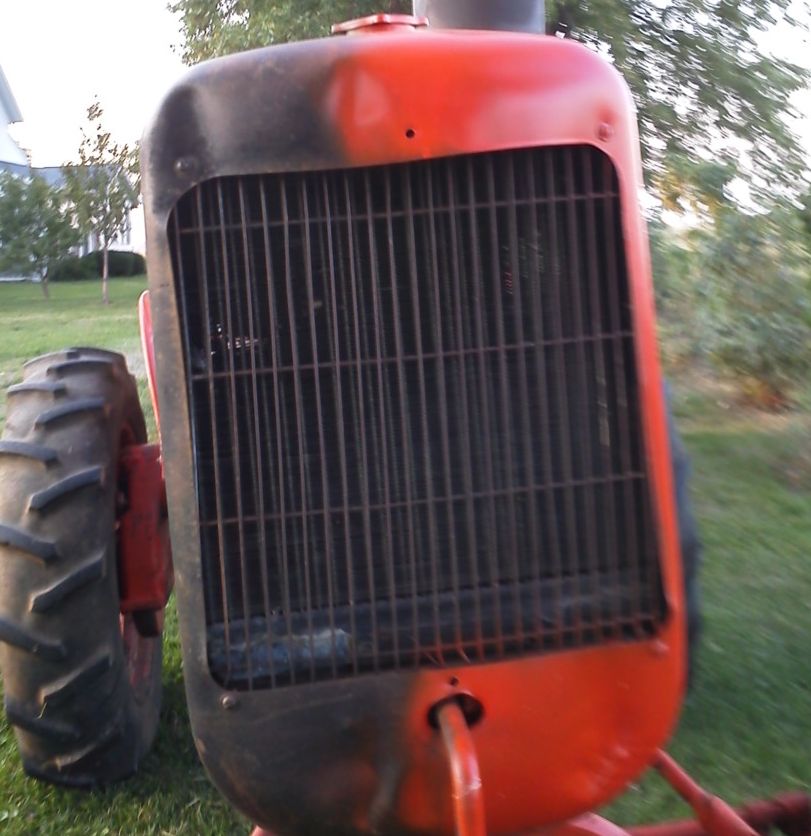| Author |
|
G226WD 
Bronze Level

Joined: 06 Jul 2011
Location: Canada
Points: 34
|
 Post Options Post Options
 Thanks(0) Thanks(0)
 Quote Quote  Reply Reply
 Topic: 10si exciter wire Topic: 10si exciter wire
Posted: 16 Nov 2023 at 1:26pm |
|
Hi I'll explain as best I can,
I have a 10si alternator I'd like to put a diode in the exciter wire on my wd so power flows to battery and not battery to alternator. Not sure if I need a better multimeter to test properly. Talked to a guy in town and he said he has 2 amp, 5 amp and 10 amp diodes in stock but bigger ones he would have to order it special. I am talking about the exciter wire only not the bigger wire. I have been using a cheap harbour freight type batt terminal disconnect for a while but it doesn't work too good if the tractor is left outside. alternator is 40amp 12v on a 49 wd. Steve(ill) care to comment?
Thanks
Edited by G226WD - 16 Nov 2023 at 2:44pm
|
 |
|
Sponsored Links
|
|
 |
Jim.ME 
Orange Level

Joined: 19 Nov 2016
Location: Maine
Points: 962
|
 Post Options Post Options
 Thanks(0) Thanks(0)
 Quote Quote  Reply Reply
 Posted: 16 Nov 2023 at 7:14pm Posted: 16 Nov 2023 at 7:14pm |
A diode is not used in the alternator output wire.
A diode is used in the alternator excitation wire. The exciter wire should not be connected directly to the battery. It should be powered from a switched source. The diode is to prevent back feed from the exciter terminal to the ignition switch when the engine is shut off. Depending on how it is connected to the switch and what else is connected to that same switch terminal, that back feed from the exciter terminal can prevent the engine from shutting off. A 2 to 5 amp, 50-volt diode will work in the exciter wire. If a universal ignition switch, with an accessory terminal is used it is possible to wire the excitation wire to the accessory terminal (best if it alone is on that terminal) without using a diode, the switch design will prevent the back feed issue. Another method is to use an indicator light wired into the exciter wire. You need an insulated base lamp holder (2 wires) as the lamp holder must be wired into the excitation wire in series. And an incandescent bulb is required, LEDs are not chosen for this task. You could route the excitation wire through a normally open oil pressure switch, that will cut power to the alternator excitation terminal when the engine is stopped. A number of Massey Fergusons used an oil pressure switch to control the alternator excitation and gauges on the diesels where there were no ignition switches. The oil pressure switches were fed direct from a battery power source.
If you want to prevent any battery drain when shut off use a battery disconnect switch, these are generally installed in the ground (negative in your case) battery cable.
Edited by Jim.ME - 16 Nov 2023 at 7:19pm
|
 |
steve(ill) 
Orange Level Access


Joined: 11 Sep 2009
Location: illinois
Points: 88173
|
 Post Options Post Options
 Thanks(0) Thanks(0)
 Quote Quote  Reply Reply
 Posted: 16 Nov 2023 at 9:02pm Posted: 16 Nov 2023 at 9:02pm |
as Jim said, you need something in the Excitation wire to drop the voltage slightly and get it to START CHARGE.. You can use a DIODE, a LIGHT BULB or a RESISTOR... I tend to use the resistor as they are very "weather friendly".. have some that are pushing 20 years of use.. 10 ohm, 10 watt is about 3/8 inch square and 3 inches long..
Also, the Excitation is connected to the Ignition switch as Jim said.. That shuts everything OFF when you turn off the motor..
|
|
Like them all, but love the "B"s.
|
 |
steve(ill) 
Orange Level Access


Joined: 11 Sep 2009
Location: illinois
Points: 88173
|
 Post Options Post Options
 Thanks(0) Thanks(0)
 Quote Quote  Reply Reply
 Posted: 16 Nov 2023 at 9:05pm Posted: 16 Nov 2023 at 9:05pm |
something like this.. They normally run $1 each... Use to get them at Radio Shack.. This is AMAZON.. ... I mount a small double terminal block and put the wires on 2 screws and this resistor leads on the other two screws...
Edited by steve(ill) - 16 Nov 2023 at 9:08pm
|
|
Like them all, but love the "B"s.
|
 |
im4racin 
Orange Level

Joined: 12 Jun 2017
Location: Garrison ND
Points: 1068
|
 Post Options Post Options
 Thanks(0) Thanks(0)
 Quote Quote  Reply Reply
 Posted: 16 Nov 2023 at 9:12pm Posted: 16 Nov 2023 at 9:12pm |
|
I know the 10a will work but think the 2a will work. It’s not looking for much amperage and it’s only when not spinning at speed to self excite.
|
 |
Jim.ME 
Orange Level

Joined: 19 Nov 2016
Location: Maine
Points: 962
|
 Post Options Post Options
 Thanks(0) Thanks(0)
 Quote Quote  Reply Reply
 Posted: 16 Nov 2023 at 9:33pm Posted: 16 Nov 2023 at 9:33pm |
|
I could be wrong, but I don't think you don't need to drop the voltage in the excitation wire to start the alternator charging. You can start a negative ground alternator charging by using a jumper wire direct from the battery positive post. The oil pressure switches on Massey Fergusons and others that use them put direct battery voltage to the alternator excitation terminal. My understanding has always been that a diode, lamp, resistor, or lamp with resistor is used in the excitation wire to prevent back feed voltage coming from the exciter terminal of the running alternator from powering anything that might be connected to the same circuit, via the terminal of the ignition switch, when the key is shut off. A diode does not reduce voltage it is a one-way valve so to speak. The lamp and resistor do reduce voltage, in both directions, such that they prevent run on caused by alternator back feed when the key is shut off. The alternator will be excited with the reduced voltage coming from the switch through them, however reducing the voltage is not required to start the alternator charging. At least that's how I learned it.
|
 |
steve(ill) 
Orange Level Access


Joined: 11 Sep 2009
Location: illinois
Points: 88173
|
 Post Options Post Options
 Thanks(0) Thanks(0)
 Quote Quote  Reply Reply
 Posted: 16 Nov 2023 at 9:34pm Posted: 16 Nov 2023 at 9:34pm |
|
the resistor i use is 10 WATTS... divided by 12 VOLTS is less than 1 amp......... so i would agree the excitation line dont have much running thru it.
|
|
Like them all, but love the "B"s.
|
 |
DaveKamp 
Orange Level Access


Joined: 12 Apr 2010
Location: LeClaire, Ia
Points: 6081
|
 Post Options Post Options
 Thanks(0) Thanks(0)
 Quote Quote  Reply Reply
 Posted: 16 Nov 2023 at 11:13pm Posted: 16 Nov 2023 at 11:13pm |
|
A silicon diode exhibits 0.6v of foreward voltage drop, regardless of what is coming in and going out, it's Vf is going to be 0.6v lower than what comes in.
A Germanioum diode, a Shottky Barrier diode, and most any RF TYPE detector diodes will exhibit a lower Vf, but that's why they're detector diodes, for demodulation applications, not rectifiers.
|
|
Ten Amendments, Ten Commandments, and one Golden Rule solve most every problem. Citrus hand-cleaner with Pumice does the rest.
|
 |
Jim.ME 
Orange Level

Joined: 19 Nov 2016
Location: Maine
Points: 962
|
 Post Options Post Options
 Thanks(0) Thanks(0)
 Quote Quote  Reply Reply
 Posted: 17 Nov 2023 at 6:54am Posted: 17 Nov 2023 at 6:54am |
I accept your point on there is voltage drop through a diode (and can apply to anything). Would you say they designed and installed as voltage reducing devices in an automotive alternator excitation circuit or are they there as a "check valve" to prevent the back feeding of current from the alternator excitation circuit to the power source that provided the initial excitation power to the alternator's excitation terminal?
My point was/is there is no need to reduce the voltage being supplied to excite the alternator to make it start charging. Direct voltage delivered through an oil pressure switch, the accessory terminal of an ignition switch, a toggle switch, push button, or a jumper wire will start them charging just fine. Yes, I will agree there can be some voltage loss in those items, however I don't see that they are designed or intended for reducing voltage in automotive applications, only circuit control. I would expect a specified voltage drop would be called out for an excitation circuit if such was required to make the circuit work.
My understanding has always been they are used to stop the back feeding of power from the alternator's internal excitation circuit to supply source. A common issue without having one or more of those (lamp, resistor, or diode) in the excitation circuit (where excitation power is taken from the ignition terminal of the ignition switch) is that a gas engine (could be a diesel with electric shut off) will not shutdown when the ignition key is turned off, due to power coming back to the ignition switch from the operating alternator's internal excitation circuit. A resistor and/or lamp will reduce that voltage enough to allow shutdown and a diode will stop current flow back to the source from the alternator.
|
 |
steve(ill) 
Orange Level Access


Joined: 11 Sep 2009
Location: illinois
Points: 88173
|
 Post Options Post Options
 Thanks(0) Thanks(0)
 Quote Quote  Reply Reply
 Posted: 17 Nov 2023 at 7:51am Posted: 17 Nov 2023 at 7:51am |
A single wire alternator will charge.. but might need a higher RPM to get it to KICK IN... A 3 wire alternator that has a light bulb or resistor in the excitation line will kick in at a much lower RPM.. That is the advantage of a 3 wire alternator.
Yes, you can run an alternator with a wire to the excitation terminal... just like a 1 wire alternator....Yes, the main purpose of a diode is to stop reverse flow.. Putting a diode in the line may make the alternator "kick in" at a somewhat higher RPM compared to a resistor... similar to a single wire alternator ??????? Just a thought..
Edited by steve(ill) - 17 Nov 2023 at 8:00am
|
|
Like them all, but love the "B"s.
|
 |
steve(ill) 
Orange Level Access


Joined: 11 Sep 2009
Location: illinois
Points: 88173
|
 Post Options Post Options
 Thanks(0) Thanks(0)
 Quote Quote  Reply Reply
 Posted: 17 Nov 2023 at 7:56am Posted: 17 Nov 2023 at 7:56am |
30 years ago i got a drawing for a "test bench" from a Delco Engineer for a 10 SI alternator and they recommended a 10w 10 ohm resistor on the test bench ( I assume to get it to kick in at a low RPM) ............. 20 years later if got this drawing of a CS130 alternator on a test bench.... they also use a resistor for the testing.. somewhat higher value... I use a 100 ohm resistor for the CS130.
Edited by steve(ill) - 17 Nov 2023 at 8:56am
|
|
Like them all, but love the "B"s.
|
 |
Les Kerf 
Orange Level

Joined: 08 May 2020
Location: Idaho
Points: 1343
|
 Post Options Post Options
 Thanks(0) Thanks(0)
 Quote Quote  Reply Reply
 Posted: 17 Nov 2023 at 5:18pm Posted: 17 Nov 2023 at 5:18pm |
 steve(ill) wrote: steve(ill) wrote:
... Putting a diode in the line may make the alternator "kick in" at a somewhat higher RPM compared to a resistor... similar to a single wire alternator ??????? Just a thought..
|
I seriously doubt you would notice the difference between the two methods when used on our old AC tractors.
|
 |
Steve in NJ 
Orange Level Access


Joined: 12 Sep 2009
Location: Andover, NJ
Points: 12007
|
 Post Options Post Options
 Thanks(0) Thanks(0)
 Quote Quote  Reply Reply
 Posted: 17 Nov 2023 at 6:29pm Posted: 17 Nov 2023 at 6:29pm |
The diode is a one way valve as Jim mentioned. Jim is correct on his assumption. I use a 1 volt/50amp diode in my VR circuit to stop the backfeed. A simple 194 bulb in a pilot lamp can do the same thing. Most of my 12V conversion systems I build use a inline diode which sorta looks like an ATO flat fuse. I also use a small pilot lamp that mounts in the instrument box for customer's who requiest it. Soooo..... either way, they will both work the same..... Steve@B&B
|
|
39'RC, 43'WC, 48'B, 49'G, 50'WF, 65 Big 10, 67'B-110, 75'716H, 2-620's, & a Motorhead wife
|
 |










 Topic Options
Topic Options

 Post Options
Post Options Thanks(0)
Thanks(0)







 steve(ill) wrote:
steve(ill) wrote:
